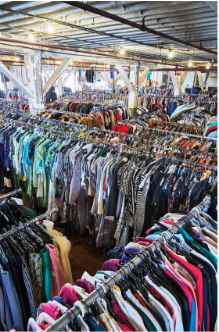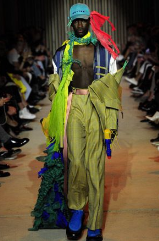Sustainable Fashion Beyond Brands
In the annals of fashion history, a seismic shift is underway. A transformation that transcends trends and surpasses the fleeting whims of the runway. Sustainable fashion, once relegated to the fringes of the industry, has stepped into the spotlight, redefining the very essence of what it means to be fashionable. It's a movement that extends far beyond the labels we wear and the brands we endorse. It's a movement driven by the choices we make as conscious consumers.

The Traditional Fashion Landscape
For decades, the fashion landscape resembled a frenetic carousel of change, with new styles and collections perpetually spinning into view. The industry reveled in its breakneck pace, churning out clothing at an astonishing rate. Fashion trends flashed across our screens and adorned the racks of stores, only to be replaced by the next big thing before we could blink.
This traditional model, often referred to as fast fashion, brought with it a host of challenges. It was a model built on excess – excess production, excess consumption, and excess waste. The rapid turnover of clothing meant that our closets overflowed with items we wore only a handful of times, if at all. And the environmental cost was staggering. From water consumption to textile waste, the fashion industry left an indelible mark on our planet.
The Rise of Sustainable Fashion Brands
As we navigated the early years of the 21st century, a new narrative began to emerge. A narrative rooted in environmental stewardship, ethical production, and longevity. Brands began to prioritize responsible sourcing of materials, fair labor practices, and a commitment to reducing their ecological footprint. Slowly but surely, sustainable fashion brands started to appear on the scene.

These pioneering brands embraced sustainable fabrics, such as organic cotton, hemp, and Tencel. They championed recycling and upcycling, giving new life to old garments. They engaged in transparent supply chains, allowing consumers to trace the journey of their clothing from source to store. And they challenged the notion of disposable fashion, creating high-quality pieces designed to stand the test of time.

The True Heroes: Conscious Consumers
While sustainable fashion brands have undoubtedly played a pivotal role in reshaping the industry, the true heroes of this narrative are the conscious consumers. They are individuals who recognize that their choices hold the power to drive meaningful change.
Thrifting and Secondhand Shopping: Conscious consumers have turned to thrifting and secondhand shopping as a way to reduce waste and support circular fashion practices. Vintage shops, thrift stores, and online resale platforms have become treasure troves of unique and eco-friendly fashion finds.
Repair and Upcycling: Rather than discarding damaged clothing, conscious consumers embrace repair and upcycling. They sew, patch, and repurpose garments, breathing new life into old favorites.
Capsule Wardrobes: The concept of a capsule wardrobe revolves around curating a collection of versatile, high-quality pieces that can be mixed and matched. This approach reduces consumption and encourages thoughtful buying.
Sustainable Fabrics: Conscious consumers choose clothing made from sustainable fabrics like organic cotton, Tencel, and recycled materials. This reduces the demand for resource-intensive materials.
Local and Artisanal Purchases: They support local artisans and businesses, reducing the carbon footprint associated with long-distance shipping. This practice also promotes ethical production and fosters a sense of community.
Ethical Brands and Transparency: Conscious consumers actively seek out brands that prioritize ethical production, fair wages, and transparent supply chains. They use their purchasing power to support companies that align with their values.
Clothing Rental and Swapping: Renting clothing for special occasions and participating in clothing swaps are sustainable alternatives to purchasing new items.
Educating and Advocating: Conscious consumers educate themselves about sustainable fashion and advocate for change within the industry. They use their voices and purchasing power to demand better practices.
Fashion with a Purpose
Conscious consumer choices extend beyond the realm of aesthetics. They reflect a deep commitment to a more equitable and ecologically sound world. These choices align with broader societal values:
Reducing Waste: Conscious consumers actively contribute to waste reduction by choosing sustainable options and extending the lifespan of their clothing.
Supporting Fair Labor Practices: They stand in solidarity with workers in the fashion industry, advocating for fair wages and safe working conditions.
Mitigating Climate Impact: Conscious consumers recognize the fashion industry's contribution to climate change and take steps to reduce it.
Fostering Innovation: Their demand for sustainable fashion fuels innovation, pushing brands to explore eco-friendly materials and production methods.
Promoting Social Responsibility: Conscious consumer choices encourage brands to prioritize social responsibility and transparency, ultimately holding them accountable for their actions.
Sustainable fashion, often thought of as an abstract concept, has become a tangible reality through the choices of these conscious consumers. Thrifting and secondhand shopping have transformed the act of finding clothing into a treasure hunt, simultaneously reducing waste and promoting the circular economy. Repair and upcycling have breathed new life into beloved garments, transforming them from worn to cherished. Capsule wardrobes have shifted the focus from quantity to quality, encouraging us to buy with intention and cherish what we own.

But the impact extends far beyond the personal wardrobe. Conscious consumers make deliberate choices that reverberate through the entire fashion industry. They choose sustainable fabrics, driving demand for organic cotton, hemp, and recycled materials. They support local artisans, fostering a sense of community and reducing the carbon footprint associated with long-distance shipping. They seek out ethical brands with transparent supply chains, holding them accountable for their actions.
These choices are not made in isolation; they are driven by values that align with broader societal goals. Conscious consumers understand that their decisions contribute to waste reduction, support fair labor practices, and mitigate fashion's climate impact. They recognize that their demand for sustainability fuels innovation, encouraging brands to explore eco-friendly materials and production methods. Their choices promote social responsibility within the industry, advocating for greater transparency and ethical standards.
Sustainable fashion is not merely a trend; it's a movement with a mission. It transcends borders, uniting individuals from diverse backgrounds in a shared commitment to protecting our planet and ensuring a brighter, more equitable future for all. It challenges the status quo, disrupts harmful practices, and paves the way for a fashion industry that respects both people and the planet.
In conclusion, sustainable fashion is not confined to brands; it's a collective endeavor driven by conscious consumers who understand that their choices matter. The power to transform the fashion industry lies not in the hands of a few, but in the hearts and minds of many. As we navigate this ever-evolving landscape of fashion, let us continue to make choices that reflect our values and propel the sustainable fashion revolution forward. Together, we can fashion a future where style coexists harmoniously with sustainability, ethics, and conscious consumerism—a future where fashion truly becomes a force for good.








